Grain elevator
A grain elevator is an agrarian facility complex designed to stockpile or store grain. In grain trade, the term grain elevator also describes a tower containing a bucket elevator or a pneumatic conveyor, which scoops up grain from a lower level and deposits it in a silo or other storage facility.
| Grain elevator | |
|---|---|
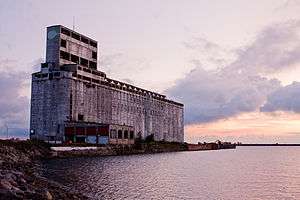 |
In most cases, the term grain elevator also describes the entire elevator complex, including receiving and testing offices, weighbridges, and storage facilities. It may also mean organizations that operate or control several individual elevators, in different locations. In Australia the term grain elevator describes only the lifting mechanism. (See "Usage", below.)
Before the advent of the grain elevator, grain was usually handled in bags rather than in bulk (large quantities of loose grain). Dart's Elevator was a major innovation. It was invented by Joseph Dart, a merchant, and Robert Dunbar, an engineer, in 1842 and 1843, in Buffalo, New York. Using the steam-powered flour mills of Oliver Evans as their model, they invented the marine leg, which scooped loose grain out of the hulls of ships and elevated it to the top of a marine tower.[1]
Early grain elevators and bins were often built of framed or cribbed wood, and were prone to fire. Grain-elevator bins, tanks, and silos are now usually made of steel or reinforced concrete. Bucket elevators are used to lift grain to a distributor or consignor, from which it falls through spouts and/or conveyors and into one or more bins, silos, or tanks in a facility. When desired, silos, bins, and tanks are emptied by gravity flow, sweep augers, and conveyors. As grain is emptied from bins, tanks, and silos it is conveyed, blended, and weighted into trucks, railroad cars, or barges for shipment.
Usage and definitions
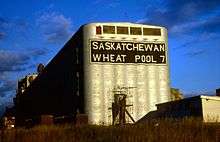
In Australian English, the term "grain elevator" is reserved for elevator towers, while a receival and storage building or complex is distinguished by the formal term receival point or as a "wheat bin" or "silo". Large-scale grain receival, storage, and logistics operations are known in Australia as bulk handling.
In Canada, the term "grain elevator" is used to refer to a place where farmers sell grain into the global grain distribution system, and/or a place where the grain is moved into rail cars or ocean-going ships for transport. Specifically there are several types of grain elevators under Canadian law, defined in the Canadian Grain Act, Section 2.[2]
- Primary elevators (called "country elevators" before 1971) receive grain directly from producers for storage, forwarding, or both.
- Process elevators (called "mill elevators" before 1971) receive and store grain for direct manufacture or processing into other products.
- Terminal elevators receive grain on or after official inspection and weighing and clean, store, and treat grain before moving it forward.
- Transfer elevators (including "Eastern elevators" from the pre-1971 classification) transfer grain that has been officially inspected and weighed at another elevator. In the Eastern Division, transfer elevators also receive, clean, and store eastern or foreign grain.
History
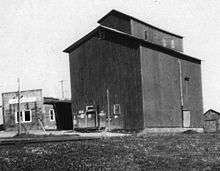
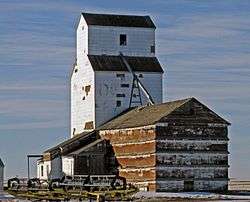
It was both necessity and the prospect of making a lot of money that gave birth to the steam-powered grain elevator in Buffalo, New York, in 1843. Due to the completion of the Erie Canal in 1825, Buffalo enjoyed a unique position in American geography. It stood at the intersection of two great all-water routes: one extending from New York Harbor, up the Hudson River, to Albany and, beyond it, the Port of Buffalo; the other constituted by the Great Lakes, which could theoretically take boaters in any direction they wished to go (north to Canada, west to Michigan or Wisconsin, south to Toledo and Cleveland, or east to the Atlantic Ocean). All through the 1830s, Buffalo benefited tremendously from its position. In particular, it was the recipient of most of the increasing quantities of grain (mostly wheat) that was being grown on farms in Ohio and Indiana, and shipped on Lake Erie for transshipment to the Erie Canal. If Buffalo had not been there, or when things got backed up there, that grain would have been loaded onto boats at Cincinnati and shipped down the Mississippi River to New Orleans.[1]
By 1842, it was clear that Buffalo's port facilities were antiquated. They still relied upon techniques that had been in use since the European Middle Ages: work teams of stevedores would use block and tackles and their own backs to unload or load each and every sack of grain that had been stored or was to be stored in the boat's hull. It would take several days, sometimes even a week, to service a single grain-laden boat. Grain shipments were going down the Mississippi River, not over the Great Lakes/Erie Canal system.
A merchant named Joseph Dart, Jr., is generally credited as being the one who adapted Oliver Evans' grain elevator (originally a manufacturing device) for use in a commercial framework (the transshipment of grain in bulk from lakers to canal boats), but the actual design and construction of the world's first steam-powered "grain storage and transfer warehouse" was executed by an engineer named Robert Dunbar. Thanks to the historic Dart's Elevator (operational on 1 June 1843), which worked almost seven times faster than its non-mechanized predecessors, Buffalo was able to keep pace with—and thus further stimulate—the rapid growth of American agricultural production in the 1840s and 1850s, but especially after the Civil War, with the coming of the railroads.[1]
The world's second and third grain elevators were built in Toledo, Ohio and Brooklyn, New York, in 1847. These fledgling American cities were connected through an emerging international grain trade of unprecedented proportions. Grain shipments from farms in Ohio were loaded onto ships by elevators at Toledo; these ships were unloaded by elevators at Buffalo that transshipped their grain to canal boats (and, later, rail cars), which were unloaded by elevators in Brooklyn, where the grain was either distributed to East Coast flour mills or loaded for further transshipment to England, the Netherlands, or Germany. But this eastern flow of grain was matched by an equally important flow of people and capital in the opposite direction, that is, from East to West. Because of the money to be made in grain production and, of course, because of the very existence of an all-water route to get there, increasing numbers of immigrants in Brooklyn came to Ohio, Indiana, and Illinois to become farmers. More farmers meant more prairies turned into farmlands, which in turn meant increased grain production, which of course meant that more grain elevators would have to be built in places like Toledo, Buffalo, and Brooklyn (and Cleveland, Chicago, and Duluth). Through this loop of productivity set in motion by the invention of the grain elevator, the United States became a major international producer of wheat, corn and oats.[1]
In the early twentieth century, there was concern about monopolistic practices in the grain elevator industry, leading to testimony before the Interstate Commerce Commission in 1906.[3] This led to several grain elevators being burned down in Nebraska, allegedly in protest.[3]
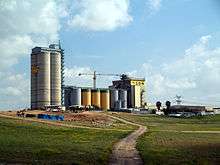
Today, grain elevators are a common sight in the grain-growing areas of the world, such as the North American prairies. Larger terminal elevators are found at distribution centers, such as Chicago and Thunder Bay, Ontario, where grain is sent for processing, or loaded aboard trains or ships to go further afield.
Buffalo, New York, the world's largest grain port from the 1850s until the first half of the 20th century, once had the United States' largest capacity for the storage of grain in over thirty concrete grain elevators located along the inner and outer harbors. While several are still in productive use, many of those that remain are presently idle. In a nascent trend, some of the city's inactive capacity has recently come back online, with an ethanol plant started in 2007 using one of the previously mothballed elevators to store corn. In the early 20th century, Buffalo's grain elevators inspired modernist architects such as Le Corbusier, who exclaimed, "The first fruits of the new age!" when he first saw them. Buffalo's grain elevators have been documented for the Historic American Engineering Record and added to the National Register of Historic Places. Currently, Enid, Oklahoma, holds the title of most grain storage capacity in the United States.
In farming communities, each town had one or more small grain elevators that would serve the local growers. The classic grain elevator was constructed with wooden cribbing and had nine or more larger square or rectangular bins arranged in 3 × 3 or 3 × 4 or 4 × 4 or more patterns. Wooden cribbed elevators usually had a driveway with truck scale and office on one side, a rail line on the other side and additional grain storage annex bins on either side.
In more recent times with improved transportation, centralized and much larger elevators serve many farms. Some of them are quite large. Two elevators in Kansas (one in Hutchinson and one in Wichita) are half a mile long. The loss of the grain elevators from small towns is often considered a great change in their identity, and there are efforts to preserve them as heritage structures. At the same time, many larger grain farms have their own grain handling facilities for storage and loading onto trucks.
Grain elevator operators buy grain from farmers, either for cash or at a contracted price, and then sell futures contracts for the same quantity of grain, usually each day. They profit through the narrowing basis, that is, the difference between the local cash price, and the futures price, that occurs at certain times of the year.
Before economical truck transportation was available, grain elevator operators would sometimes use their purchasing power to control prices. This was especially easy since farmers often had only one elevator that was within a reasonable distance of their farm. This led some governments to take over the administration of grain elevators. An example of this is the Saskatchewan Wheat Pool. For the same reason, many elevators were purchased by cooperatives.
A recent problem with grain elevators is the need to provide separate storage for ordinary and genetically modified grain to reduce the risk of accidental mixing of the two.
In the past, grain elevators sometimes experienced silo explosions. Fine powder from the millions of grains passing through the facility would accumulate and mix with the oxygen in the air. A spark could spread from one floating particle to the other creating a chain reaction that would destroy the entire structure. (This dispersed-fuel explosion is the mechanism behind fuel-air bombs.) To prevent this, elevators have very rigorous rules against smoking or any other open flame. Many elevators also have various devices installed to maximize ventilation, safeguards against overheating in belt conveyors, legs, bearing, and explosion-proof electrical devices such as electric motors, switches, and lighting.
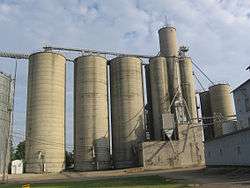
Grain elevators in small Canadian communities often had the name of the community painted on two sides of the elevator in large block letters, with the name of the elevator operator emblazoned on the other two sides. This made identification of the community easier for rail operators (and, incidentally, for lost drivers and pilots). The old community name would often remain on an elevator long after the town had either disappeared or been amalgamated into another community; the grain elevator at Ellerslie, Alberta, remained marked with its old community name until it was demolished, which took place more than twenty years after the village had been annexed by the City of Edmonton.
One of the major historical trends in the grain trade has been the closure of many smaller elevators, and the consolidation the grain trade to fewer places and among fewer companies. For example, in 1961 there were 1642 "country elevators" (the smallest type) in Alberta, holding 3,452,240 tonnes (3,397,720 long tons; 3,805,440 short tons) of grain. By 2010 there were only 79 remaining "primary elevators" (as they are now known), holding 1,613,960 tonnes (1,588,470 long tons; 1,779,090 short tons).
In 2017, the United States had 25 billion US bushels (0.88 km3) of storage capacity, a growth of 25% in the previous decade[5]
Elevator Alley

The city of Buffalo, New York is not only the birthplace of the modern grain elevator, but has the world's largest number of extant examples.[6] A number of the city's historic elevators are clustered along "Elevator Alley", a narrow stretch of the Buffalo River immediately adjacent to the harbor. The alley runs under Ohio Street and along Childs Street in the city's First Ward neighborhood.[7]
Elevator row
In Canada the term elevator row refers to a row of four or more wood-crib prairie grain elevators.
In the early pioneer days of Western Canada's prairie towns, when a good farming spot being settled, many people wanted to make money by building their own grain elevators. This brought in droves of private grain companies. Towns boasted dozens of elevator companies which all stood in a row along the railway tracks. If a town was lucky enough to have two railways, it was to be known as the next Montreal. In many elevator rows there would be two or more elevators of the same company. Small towns bragged of their large elevator rows in promotional pamphlets to attract settlers. With so much competition in the 1920s, consolidation began almost immediately, and many small companies were merged or absorbed into larger companies.
In the mid-1990s, with the cost of grain so low, many private elevator companies once again had to merge, this time causing thousands of "prairie sentinels" to be torn down. Because so many grain elevators have been torn down, Canada has only two surviving elevator rows; one located in Inglis, Manitoba, and the other in Warner, Alberta. The Inglis Grain Elevators National Historic Site has been protected as a National Historic Sites of Canada. The Warner elevator row is as of 2019 not designated a historic site, and is still in use as commercial grain elevators.
Elevator companies
Australia
- ABB Grain – founded as a mutual company, the Australian Barley Board, in 1939, by barley growers in South Australia and Victoria; after demutualization, it was acquired by Viterra (see below) in 2009; Australian Bulk Alliance, a joint venture between ABB and Sumitomo, operates facilities in some areas.
- CBH Group – a cooperative company, established by grain growers in Western Australia, in 1933
- GrainCorp – established by the Government of New South Wales in 1917, as Government Grain Elevator and was privatized in 1992
Canada
All companies operating elevators in Canada are licensed by the Canadian Grain Commission.[8]
- Agricore United – taken over by Saskatchewan Wheat Pool in 2007
- Alberta Farmers' Co-operative Elevator Company, merged into United Grain Growers in 1917
- Alberta Pacific Grain Company – taken over by Federal Grain Co. in 1967[9]
- Alberta Wheat Pool – merged with Manitoba Pool Elevators in 1997
- Cargill – established in 1865 by W.W. Cargill
- Federal Grain – sold to the three Provincial wheat pools in 1972
- Grain Growers' Grain Company, merged into United Grain Growers in 1917
- Lake of the Woods Milling Company
- Manitoba Pool Elevators – merged with Alberta Wheat Pool in 1997
- Parrish & Heimbecker – established in 1909 by two families William Parrish and Norman G. Heimbecker
- Paterson grain – established in 1908 as the N. M. Paterson Co.
- Richardson International – established in 1857 by James Richardson. Also known as Richardson Pioneer
- Saskatchewan Co-operative Elevator Company, taken over by the Saskatchewan Wheat Pool in 1926
- Saskatchewan Wheat Pool – took over Agricore United in 2007 to form Viterra
- United Grain Growers – taken over by Agricore United in 2001
- Viterra – established after the take-over of Agricore United by the Saskatchewan Wheat Pool
Sweden
- In Sweden, the vast majority of grain elevators belong to the Lantmännen co-operative movement, owned by grain-growing farmers.
United States
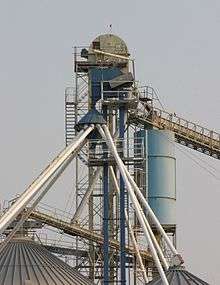
Notable grain elevators
During the Battle of Stalingrad, one particularly well-defended Soviet strongpoint was known simply as "the Grain Elevator" and was strategically important to both sides.
This is a list of grain elevators that are either in the process of becoming heritage sites, museums, or have been preserved for future generations.
Canada
Alberta


- Acadia Valley – Prairie Elevator Museum, former Alberta Wheat Pool converted into a tea house and museum[10]
- Alberta Central Railroad Museum – former Alberta Wheat Pool, second-oldest standing grain elevator in Alberta, moved from Hobbema[11]
- Andrew – former Alberta Wheat Pool, restored into a museum
- Castor – former Alberta Pacific, restored into a museum[12]
- Big Valley – Alberta Wheat Pool used as a museum complete with a train station and roundhouse[13]
- Edmonton – Ritchie Mill, former flour mill converted into restaurants, law offices, and condominiums[14]
- Ellis Bird Farm, built in 1937, oldest standing seed elevator in Alberta
- Esther – former Alberta Wheat Pool, restored into a museum
- Haselwood Mill – Alberta's oldest seed-cleaning mill, second on the site, privately owned, not protected, operated from the 1930s to 1960s near Bittern Lake, Alberta
- Heritage Acres Farm Museum – restored United Grain Growers elevator moved from Brocket[15]
- Heritage Park Historical Village, former Security Elevator Co. LTD. moved from Shonts[16]
- Kinuso – United Grain Growers with original UGG Logo
- Leduc – former Alberta Wheat Pool saved from demolition now a museum[17]
- Lougheed – Former Pioneer Elevator now part of the Iron Creek Museum
- Mayerthorpe – 1966 Federal Grain Co. now an interpretive center[18]
- Meeting Creek – a refurbished Alberta Wheat Pool, Pacific Grain elevator and CN train station[19]
- Nanton – Canadian Grain Elevator Discovery Centre, three elevators saved from demolition and preserved to educate visitors about the town's, and Alberta's, agricultural history[20]
- Radway – Krause Milling Co. restored into a museum[21]
- Raley – oldest standing grain elevator on its original site in Alberta, built in 1909 maintaining many of its original features
- Rowley – a United Grain Growers, and Alberta Wheat Pool elevators saved from demolition by locals and now fully restored
- Scandia – Scandia Eastern Irrigation District Museum, 1920s Alberta Wheat Pool and stockyard now a museum
- South Peace Centennial Museum, United Grain Growers moved from Albright[22]
- Spruce Grove – Spruce Grove Grain Elevator Museum, former Alberta Wheat Pool, now a museum
- St. Albert – St. Albert Grain Elevator Park,[23] a 1906 Alberta Grain Co. and 1929 Alberta Wheat Pool Elevators now restored as a historic park[24]
- Stettler – 1920 Parrish and Heimbecker grain elevator, feed mill, and coal shed, last to stand in Alberta, now protected and restored as a museum[25]
- Ukrainian Cultural Heritage Village – Former Home Grain Co. moved from Bellis[26]
British Columbia
- Creston – former Alberta Wheat Pool (1936) and United Grain Growers (1937) elevators that still stand tall on the edge of the downtown core in the middle of the Creston Valley
- Dawson Creek – restored and refurbished as a community art gallery
Manitoba
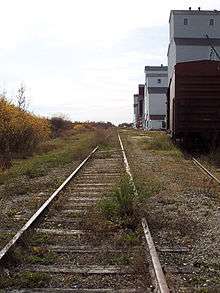
- Inglis – Inglis elevator row, last surviving elevator row in Manitoba with a total of four elevators. Now designated and protected as a National Historic Site of Canada
- Niverville – Western Canada's first grain elevator, erected by William Hespeler in 1879[27]
- Plum Coulee – grain elevator refurbished as a restaurant and meeting rooms
Ontario
- Scugog – Canada's oldest grain elevator and the second oldest in all of the Americas
- Stiver Mills – one of a few surviving grain elevators in Ontario, built 1916 and used until 1968 and now a farmers' market
Quebec
- Silo No. 5, Montreal – This grain elevator was completed in four stages from 1906 to 1959 and was abandoned in 1994. With the demolition of Silo No. 1 and Silo No. 2, Silo No. 5 is now, along with the Old Port’s conveyor pier tower, the last vestige of Old Montreal’s 20th-century harbour panorama.[28]
Saskatchewan
- Edam – former Saskatchewan Wheat Pool now a museum
- Gravelbourg – Former Saskatchewan Wheat Pool saved from demolition and now a museum
- Indian Head – experimental farm grain elevator refurbished as a Café, coffee house
- Sukanen Ship Pioneer Village and Museum – former Victoria – McCabe moved from Mawer[29]
- Val Marie – former Federal and 1967 Centennial Saskatchewan Wheat Pool now museums
- North Battleford Western Development Museum, former Saskatchewan Wheat Pool moved from Keatley[30]
- Weyburn Inland Terminal – first large farmer owned inland terminal in Canada, constructed in 1975 located near Weyburn
- Wood Mountain – former Saskatchewan Wheat Pool No. 706, demolished April 22, 2014
South Africa
- Port of Cape Town – once the tallest building in Cape Town, now restored to become the Zeitz Museum of Contemporary Art Africa
Switzerland
- Swissmill Tower in upper Limmat Valley in the Canton of Zürich – 118 metres (387 ft) high, rebuilt by April 2016.[31]
United States
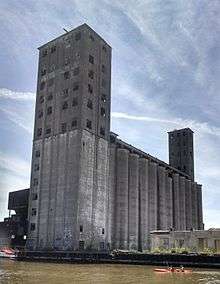

Baltimore, Maryland
- Baltimore and Ohio Locust Point Grain Terminal Elevator, one of the largest grain terminal elevators to be constructed in the early 20th century, with a capacity of 3.8 billion US bushels (130,000,000 m3) in Baltimore, Maryland
- Silo Point, currently being reconstructed from a grain elevator to a condominium located in Baltimore, Maryland
Buffalo, New York
- American Grain Complex, built between 1905 and 1931
- Cargill Pool Elevator, previously named the Saskatchewan Cooperative Elevator was built in 1925 offered a total holding capacity of 2.1 million US bushels (74,000 m3) in 135 bins
- Cargill Superior elevator, marked as Cargill "S", built between 1914 and 1925
- Concrete-Central Elevator, Buffalo, New York – The largest transfer elevator in the world at the time of its completion in 1917
- Connecting Terminal, Clearly visible from across canalside and the Commercial Slip the structure is now used for boat storage
- General Mills Plant, or "The Frontier Elevator" General Mills Buffalo factory is a large scale grain mill and cereal production facility, most notably producing Gold Medal brand flour, Wheaties, Cheerios, and other General Mills brand cereals
- Great Northern Elevator, built in 1897 by the Great Northern Railroad
- Lake & Rail Grain Elevator, part of the "elevator alley" – The Lake and Rail produces over 2,700,00 pounds of flour a day
- Marine A grain elevator, also part of the "elevator alley" and across from the Lake & Rail Grain Elevator
- The Standard Elevator – named after the Standard Milling Company and built in 1926
- Wheeler Elevator – also known as the Agway/GLF East Work House, built in 1908
- Wollenberg Grain and Seed Elevator – wooden "country style" elevator formerly located in Buffalo, New York; destroyed by fire in October 2006
Wassaic, New York
- Maxon Mills – built in 1954 and remained in active use as a feed elevator until the 1980s. The mill was placed on the New York State Register of Historic Places and restored in the early 2000s. It is currently used as a contemporary art exhibition space by The Wassaic Project
Illinois
- Armour's Warehouse – constructed in 1861–62 on the north bank of the Illinois-Michigan Canal in Seneca, Illinois
Iowa
- Bouton, Iowa's grain elevator – owned by Susan (formerly Flanery) & Michael Chris Brelsford, photo shoot location for the 40th Anniversary Sports Illustrated Swimsuit Issue (2004)
Minnesota
- Northwestern Consolidated Milling Company Elevator A, also known as the Ceresota Building and "The Million Bushel Elevator", was a receiving and public grain elevator built by the Northwestern Consolidated Milling Company in 1908 in Minneapolis, Minnesota
- Peavey–Haglin Experimental Concrete Grain Elevator, St. Louis Park, Minnesota, built in 1899–1900
- Saint Paul Municipal Grain Terminal, in St. Paul, Minnesota, on the NRHP
North Dakota
- North Dakota Mill and Elevator, largest flour mill in the United States, located in Grand Forks, North Dakota
Oklahoma
- Bricktown, Oklahoma City, Oklahoma is home to OKC Rocks, a former grain elevator that has been turned into an indoor rock climbing facility located in Oklahoma City, Oklahoma[32]
- Ingersoll Tile Elevator, elevator constructed of hollow red clay tiles, located in Ingersoll, Oklahoma
Philadelphia, Pennsylvania
- Reading Company Grain Elevator, export elevator in Philadelphia converted into offices
South Dakota
- Zip Feed Tower, tallest occupiable structure in South Dakota from its construction in 1956–1957 until its demolition in December 2005
Virginia
- Sewell's Point grain elevator, export elevator built by the city of Norfolk in 1922 to help the port of Norfolk better compete with other East Coast ports by providing a publicly owned facility to store and load grain at reasonable rates. It was sold to the Norfolk and Western railroad in 1929, and leased from N&W by Continental grain in 1952. The elevator originally held 750,000 bushels but was later expanded to 3.5 million bushels. The elevator was taken over by Cargill in the late 1980s and abandoned around the turn of the 21st century. The elevator was demolished by Norfolk Southern in 2008.[33]
- Southern States silos, a grain elevator in Richmond, Virginia originally built in the 1940s by Cargill and currently leased by Perdue Farms is the tallest structure south of the James River in the city of Richmond. The elevator was the site of the 3rd RVA Street Art Festival.[34][35]
Wisconsin
- Chase Grain Elevator, tile grain elevator built in 1922. Sun Prairie, Wisconsin Placed on the National Register of Historic Places in 2010. It is the last remaining tile elevator in Wisconsin.
Wyoming
- Sheridan Flouring Mills, Inc., an industrial complex in Sheridan, Wyoming
Elevator explosions
Given a large enough suspension of combustible flour or grain dust in the air, a significant explosion can occur. A historical example of the destructive power of grain explosions is the 1878 explosion of the Washburn "A" Mill in Minneapolis, Minnesota, which killed eighteen, leveled two nearby mills, damaged many others and caused a destructive fire that gutted much of the nearby milling district. (The Washburn "A" mill was later rebuilt and continued to be used until 1965.) Another example occurred in 1998, when the DeBruce grain elevator in Wichita, Kansas, exploded and killed seven people.[36] The most recent example is an explosion on October 29, 2011, at the Bartlett Grain Company in Atchison, Kansas. The death toll was six people. Two more men received severe burns, but the remaining four were not hurt.[37]
Almost any finely-divided organic substance becomes an explosive material when dispersed as an air suspension; hence, a very fine flour is dangerously explosive in air suspension. This poses a significant risk when milling grain to produce flour, so mills go to great lengths to remove sources of sparks. These measures include carefully sifting the grain before it is milled or ground to remove stones which could strike sparks from the millstones, and the use of magnets to remove metallic debris able to strike sparks.
The earliest recorded flour explosion took place in an Italian mill in 1785, but there have been many since. The following two references give numbers of recorded flour and dust explosions in the United States in 1994[38] and 1997[39] In the ten-year period up to and including 1997, there were 129 explosions.
Media
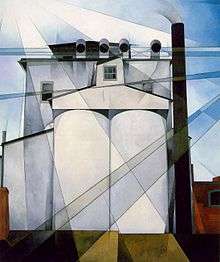
Canadian Prairie grain elevators were the subjects of the National Film Board of Canada documentaries Grain Elevator[40] and Death of a Skyline.[41]
During the sixth season of the History Channel series Ax Men, one of the featured crews takes on the job of dismantling the Globe Elevator in Wisconsin. This structure was the largest grain storage facility in the world when it was built in the 1880s.
References
- Brown, William J. (2013). American Colossus: The Grain Elevator 1843 to 1943. Colossal Books. ISBN 978-0578012612.
- "Descriptions of types of grain elevators licensed by the Canadian Grain Commission". Grainscanada.gc.ca. 2010-01-12. Archived from the original on 2013-11-20. Retrieved 2013-03-28.
- Testimony taken by Interstate Commerce Commission, October 15 – November 23, 1906, in matter of relations of common carriers to the grain trade, 59th Congress, Senate Document #278, Washington: Government Printing Office, 1907, pp. 28, 34–35.
- "Grain elevator explosion rocks Halifax". CBC News. 2003-08-08.
- Huffstutter, P. J.; Plume, Karl (11 April 2017). "Grains piled on runways, parking lots, fields amid global glut". Reuters. Retrieved 12 April 2017.
- "Grain Elevator Conference". Urban Design Project. State University of New York at Buffalo. Archived from the original on 4 March 2016. Retrieved 22 November 2013.
- Cook, Michael; Papciak, Bryan (2010). Elevator Alley. Furnace Press. ISBN 9780977274260.
- "licences". Grainscanada.gc.ca. 2002-05-05. Retrieved 2013-03-28.
- "Vanishing Sentinels". Vanishingsentinels.blogspot.com. 2005-12-30. Retrieved 2013-03-28.
- "Acadia Valley elevator". 2009-08-16. Archived from the original on August 16, 2009. Retrieved 2013-03-28.
- "Alberta Central Railroad Museum". Abcentralrailway.com. Retrieved 2013-03-28.
- "Castor elevator". Albertasource.ca. 2010-12-08. Retrieved 2013-03-28.
- Dean Tiegs. "Big Valley elevator". Canadiannorthern.ca. Archived from the original on 2013-10-03. Retrieved 2013-03-28.
- "Ritchie Mill – Edmonton". Rmlo.com. Retrieved 2013-03-28.
- "Heritage Acres". Heritage Acres. Retrieved 2013-03-28.
- "Calgary Heritage Park". Heritagepark.ca. Retrieved 2013-03-28.
- "Alberta Legacy Development Society – Leduc". Leducelevator.com. Retrieved 2013-03-28.
- "Mayerthorpe elevator". Mayerthorpe.ca. 2012-12-06. Archived from the original on 2016-04-04. Retrieved 2013-03-28.
- "Meeting Creek elevator". Canadiannorthern.ca. Retrieved 2013-03-28.
- "Canadian Grain Elevator Discovery Center – Nanton". Nantonelevators.com. Retrieved 2013-03-28.
- "Radway elevator". Townlife.com. 2008-09-24. Archived from the original on 2016-12-24. Retrieved 2013-03-28.
- "South Peace Centennial Museum". Spcm.ca. Retrieved 2013-03-28.
- St. Albert Grain Elevator Park Archived July 21, 2009, at the Wayback Machine
- St. Albert elevator Archived July 21, 2009, at the Wayback Machine
- "Stettler elevator". Boomtowntrail.com. Retrieved 2013-03-28.
- "Ukrainian Cultural Heritage Village". Tapor.ualberta.ca. Retrieved 2013-03-28.
- Cook, Ramsay (2005). Dictionary of Canadian Biography: De 1921 à 1930 - Ramsay Cook, Jean Hamelin. ISBN 9780802090874. Retrieved 2013-03-28.
- http://www.patrimoine-culturel.gouv.qc.ca/rpcq/detail.do?methode=consulter&id=115142&type=bien#.XNbZCtNKjOQ
- "Sukanen Ship Pioneer Village & Museum". Sukanenmuseum.ca. Archived from the original on 2013-02-18. Retrieved 2013-03-28.
- "Archived copy". Archived from the original on 2012-06-22. Retrieved 2012-04-09.CS1 maint: archived copy as title (link)
- Florian Niedermann (2016-04-27). "Der Swissmill-Tower spaltet Zürich" (in German). Limmattaler Zeitung. Retrieved 2016-05-19.
- "Climb Up OKC". ClimbUpGym.com. Climb Up, LLC.
- https://pilotonline.com/business/article_350e6467-3fc7-5ee1-9333-6f17571b4a9f.html
- "RVA Street Art Festival headed to Manchester silos". Retrieved 11 December 2016.
- "Third RVA Street Art Festival brings flood of creativity to Manchester". 19 April 2016. Retrieved 11 December 2016.
- "June 8, 1998 - DeBruce Grain Elevator Explosion". City of Wichita. City of Wichita. 1998. Archived from the original on February 12, 2008. Retrieved 2007-06-22.
- Sutton, Joe (October 30, 2011). "3 killed, 3 missing after Kansas grain elevator explosion". CNN.com.
- "A report of grain dust explosions that took place in 1994" (PDF). Archived from the original (PDF) on 2007-01-24. Retrieved 2007-06-23.
- "A report of grain dust explosions that took place in 1997" (PDF). Archived from the original (PDF) on 2007-01-24. Retrieved 2007-06-23.
- "Grain Elevator". Documentary film. National Film Board of Canada. Retrieved 22 July 2010.
- Smith, Bryan (2003). "Death of a Skyline". National Film Board of Canada. Archived from the original on 2007-12-07. Retrieved 2009-03-19.
External links
| Wikimedia Commons has media related to Grain elevators. |
- Grain elevators in West Texas
- Complete Photographic Record of the Remaining Canadian Prairie Grain Elevators
- Vanishing Landmarks: Photographs of standing and demolished Grain Elevators with information and maps.
- Grain Elevators: Buffalo's Lost Industry
- Buffalo Grain Elevators: A bibliography by The Buffalo History Museum
- Bruce Selyem, Grain Elevator Photographer
- Pixelgrain: Mapping Transition in the Canadian Prairies
- "Inside a Modern Grain Elevator" Popular Science Monthly, February 1930, p. 45. Drawing of how 1930s grain elevator worked at sea ports.
- Our Grandfathers' Grain Elevators blog with specifications of reinforced-concrete elevators